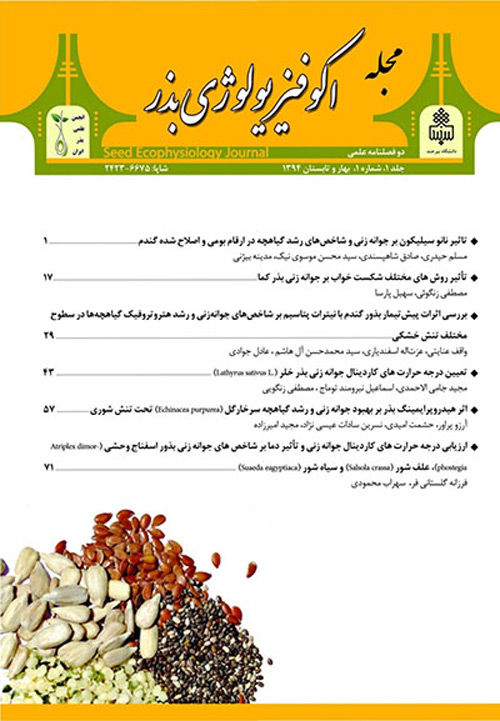Effect of prechilling media and breaking seed dormancy treatments on galbanum (Ferula gummosa Boiss.) seed germination
Galbanum is a valuable medicinal plant belonging to apiaceae family. Gum extracted from its root there are many industrial and medical applications. Because of physiological dormancy the galbanum seeds have a little germination. Physiological dormancy is common type of primary dormancy in the apiaceae family (Bewley and Black, 1994). To breaking the physiological dormancy depending on the plant species, seeds should be exposed to cold, heat, treated with Gibberllic acid or other chemicals (Bewley and Black, 1994). The effect of cytokinines on the release of seed dormancy has been proven (Sharifi and Pooresmael, 2006). To context for domestication of this plant, conservation of genetic resources and the development of medical and industrial experts, this study carryout to find the appropriate treatments for galbanum seed dormancy breaking.
This study was conducted to optimize the methods of galbanum seed dormancy breaking. For this purpose, were used two separate experiments. The first experiment was conducted by a factorial experiment based on completely randomized design with three factor and replications. This experiment factors were consisted of moist chilling duration (0, 2, 3 and 4 weeks), Gibberllic acid concentrations (0, 50, 100, 150, 500, 1000 and 1500 ppm) and type of the breaking dormancy media (sand and filter paper). The second experiment was conducted with similar plan of first experiment. This experiment factors were consisted of moist chilling duration (0, 2, 3 and 4 weeks), benzyl amino pourine concentrations (0, 0.25 and0.35 mg/L) and type of the breaking dormancy media (sand and filter paper). The seeds disinfected by using of 1 percentage sodium hypochlorite for 5 minutes. To apply moist chilling treatment, the seeds replaced within sterile filter paper layers or wet sand media as well as daily watering. Then transferred to refrigerator by 4 degree centigrade temperature. All samples after the treatments were transferred to a growth chamber with a constant temperature 12 degree centigrade. In each experiment, 20 seeds replaced on the Petri dishes with diameter of 9 cm were used. Germination percentage and rate were measured in this study.
The results showed that moist chilling was essential factor to breaking the galbanum seed dormancy. Moist chilling combined with hormones also improves the germination rate and percentage. In this regard, Zangoie et al reported that the use of Gibberllic acid combined with moist chilling was significantly increased the germination rate of Dorema ammoniacum than the single moist chilling treatment (Zangoie et al., 2013). Also Yamauchi et al (Yamauchi et al., 2004) reported that 4 degree centigrade was increased the gene expression and Gibberllic acid production on the radical and aleuronic layer, thus the combination of moist chilling and hormonal treatments can improve the germination of seeds (Yamauchi et al., 2004). Between two used hormones, the Gibberllic acid along with moist chilling showed that better seed germination compared to benzyl amino pourine along with moist chilling. Also it was found that use of sand media would have advantages for seed dormancy breaking compare with filter paper media. Stratification in moist sand as a very effective method to seed dormancy breaking on the some species such as Leymus arenariu (Greipsson, 2001). Sand composed from mineral particles that not allows for rapid decomposition in an attack by micro-organisms during stratification period. On the other hand, appropriate moisture condition in sand media due to gravity water drainage from sand resulted in moisture adjustment to the extent of field capacity, that causes adequate moisture was exist around the seeds (Nasiri, 2008). This study showed that stratification was essential agent to remove galbanum seed dormancy. Application of Gibberllic acid with moist chilling on seed germination was effective than Benzyl Amino pourine with moist chilling. It was also found that the use of moist sand media for galbanum seed dormancy breaking was better than filter paper media.
-
Evaluation of Weed Interference Effects on Yield and Yield Components of Hemp (Cannabis Sativa)
*, Jamshid Samani Pour, Hossein Hammami, Ali Reza Samadzade
, -
Evaluation of some growth traits of quinoa cultivars (Chenopodium quinoa Willd.) affected by moisture levels and planting date in two regions of South Khorasan
Farzane Golestanifar, *, Hamidreza Fallahi, Ali Shahidi
Journal of Plant Production, -
Investigation of the effects of methyl jasmonate and salicylic acid elicitors on yield and yield components of quinoa (Chenopodium quinoa Wild.) under irrigation levels
Mohamad Forouzandeh, *, , Ali Izanloo
Journal of environmental stresses in crop sciences, -
Effect of irrigation water salinity, ecotype, and plant density on the camelthorn (Alhagi camelorum Fisch.) shoot and root minerals concentration and yield
Mostafa Zangoie, *, Majid Jami Al-Ahmadi, Ali Izanloo
Journal of environmental stresses in crop sciences,




